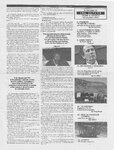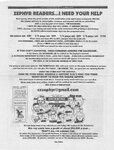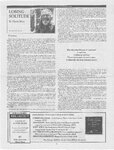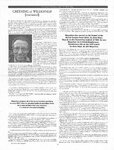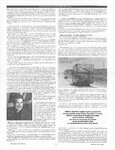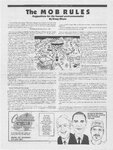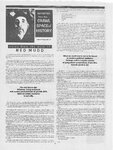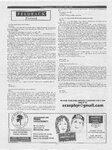| OCR Text |
Show THE ZEPHYR/AUGUST-SEPTEMBER GREENING of WILDERNE$$ (continued) © He offered as rationale both that environmentalists have an obligation to spend their members’ money wisely, and that small salaries ensure that only the passionate keep their jobs...while experience is useful, it doesn’t automatically result in better or smarter actions: ‘smart young people with fresh ideas are just as important as those who have been around the track a couple of times.’ “Brant never asked his staff do anything he wasn’t already doing....he and Susan Tixier earned a total annual salary of $20,000 between the two of them as Director and Associate Director... Brant never stopped working, whether it was leading the Utah Wilderness Coalition out of shaky consensus ae hustling money, or fixing a fleet of beater SUWA ars (he was renown for resurrecting aging office equipment and trucks). And when the Palm Beach Post, “The biggest compensation package (for Palm Beach, FL) in 2006 Fingerhut also served on the board of the Grand Canyon Trust (GCT). So does Wyss. Wyss is on the Governing Council of TWS. So was Fingerhut. So is David Bonderman. Bonderman sits on the GCT board. So does Wyss. So did Fingerhut. it seemed everything was done, he’d start cleaning the office.” Groene noted that the combined salaries of Calkin and Tixier were about a third of what the Executive Director was being paid in 2000. Now it’s closer to a quarter. In the late 1990s, SUWA found itself the belonged to Amin Khoury, 68, chairman and chief executive of Wellington-based BE Aerospace. He made $15.2 million, thanks in large part to $9.6 million in gains on stock options. Khoury also collected a salary of $904,000 and nearly $2.2 million in retirement contributions.” Khoury has made a fortune creating more comfortable airline seats. Whether Bonderman and Wyss use his creation on their GVs is unknown. beneficiary of more wealth than it might have ever dreamed possible when Hansjorg Wyss, the billionaire on TWS board joined theirs as well. He has served as SUWA’s chairman for a decade. Not only did Wyss contribute directly to SUWA’s operating funds, he bought them a new office, an old three story home in downtown Salt THE RISK of HYPOCRISY...THE COST of BEING COMPROMISED All this would be nothing more than a wealth of fascinating information about the wealthy if it were not for the troubling implications that come with it. We once argued President Clinton was a moral man with some questionable obsessions, but that his lack of fidelity to his own wife had nothing to do with his honesty and dedication to his country: Some might argue now that the opulent wealth and personal habits of this group of green benefactors has nothing to do with the goals and dreams of the conservation movement. Or that their generous contributions could ever be thought of as tainted or Bypeeniet As a leading Moab conservationist declared recently, “Money has no conscience.’ Lake City, for about $900,000 and gave an- other $500,000.to renovate and furnish it. Also joining the board was mega-millionaire Bert Fingerhut. Fingerhut also served on the board of the Grand Canyon Trust (GCT). So does Wyss. Wyss is on the Governing Council of TWS. So was Fingerhut. So is David Bonderman. Bonderman sits on the GCT board. So does Wyss. So did Fingerhut. If any citizen tries to cross-reference the participation of some of the mega-rich on these boards, the results are startling. It gets to be a bit incestuous. (NOTE: Fingerhut resigned all of his board member positions in early 2007 when he pleaded guilty to securities fraud. He is now serving But surely the people that possess that money must have a conscience. How dole it be otherwise? E And more significant, and damaging to the reputations of environmental groups is the a two year sentence in a federal correctional facility.) The same kind of wealth that came to SUWA has made its way to the Flagstaff-based Grand Canyon Trust—it is small, relative to such green powerhouses as TWS and NRDC, risk that these powerful and wealthy board members are in fact altering environmental policies and even firmly held ethical beliefs by its leaders and members to suit their own agendas. but its board of trustees, for pure money power, could go toe to toe with the Big Boys anytime. In addition to Wyss and Bonderman, GCT’s board includes (and the descrip- David Bonderman’s ability to help alter the nuclear energy policies of two of the most powerful environmental groups in the United States, almost overnight, has already been offered as a dramatic case in point. Do any of the following examples create a similar element of doubt? tions come from GCT’s web site): Lou Callister: “chairman of the law firm of Callister, Nebeker & McCullough in Salt . Lake City and is listed in “The Best Lawyers in America” in Banking Law . He is the immediate past president of and on the Board of Trustees of the Economic Development Corporation of Utah.” Pam Hait: “a principal with STRATEGIES, a marketing firm specializing in tourism development and community relations.” * In 1994, the Salt Lake Tribune reported on the growing number of backcountry/wilderness guidebooks being sold and the way different Utah environmental groups were dealing with them. “Within conservation groups,” the Tribune reported, “where-to-go journalism has become a contentious issue. While organizations like the Sierra Club sell trail guides, the Southern Utah Wilderness Alliance will not endorse any guidebook. The decision apparently came after a SUWA official allowed his accolades to be printed on Fingerhut resigned all of his board member positions in early 2007 when he pleaded guilty to securities fraud. He is now serving a two year sentence in a federal correctional facility. Carter Bales: “co-founder and general partner of The Wicks Group the back of a guidebook. The book revealed details of several little-known hiking destina- tions in Utah’s San Rafael Swell.” According to the story, then-SUWA staff attorney Scott Groene explained, “We have not actually come out yet and started burning guidebooks, but given our goals of irying to protect the land, we felt we had to adopt this policy to be consistent in our position.” To be consistent with our position... In other words, SUWA’s dedication to protecting wilderness from all kind of impacts included the damage that exploitive guidebooks could create. But a year or so later, that policy fell by the wayside. In an email to this writer in 2002, of Companies, L.L.C., a private equity firm that makes control investments in the com~ .unications, information and media industries.” Scott Groene explained the shift. products used by the semiconductor industry, with offices all over the world.” Oscar (Bud) Marx: “CEO-of TMW Enterprises, a private equity partnership with diversified investments in electronics, plastics, metal-forming, technology, and real estate.” Garry Snook: “Chairman/CEO of Performance Inc...The company has grown to be the largest specialty retailer of bicycle product, plus the largest direct merchant of cycling products through their three unique catalogue and internet companies.” — from Bonderman, $200,000 from Wyss, $75,000 from the Rodel staff Utah's most prolific guidebook writers, Steve Allen, had become SUWA’s spokesman. Traveling the country, Allen's show was called, “Canyoneering Chronicles: The Legend “Speaks,” and promoted backcountry canyoneering and the beauties of wilderness. In an article with the Tribune, “Canyoneering Allen Says More People Should See Wilderness to Save It,” Allen insisted that a mass influx of non-motorized tourists to wilderness areas was the only way to preserve our threatened wildlands. “If places get too crowded, we © can take appropriate steps (to limit access).” Imagine. Now SUWA was turning to its old adversaries at the BLM to limit and reduce the impacts from proposed increased backcountry use that SUWA wanted, in order to protect the very thing they hoped to save! Here are some more Colorado Plateau green group numbers and bits of trivia to ponder: * GCT’s net assets approached $7.5 million in 2006, up a million from the year before. It had an employee payroll in 2006 that exceeded $1 million and its executive director made $132,000 in salary, benefits and expense accounts. SUWA’s net assets passed $6 million in 2006, with a $700,000 payroll. * Among its recent donors, GCT received $1 million from the founders of INTEL, (photo above: Bert Fingerhut) “Several years ago, through the media, SUWA announced that SUWA had a ‘no guidebooks’ policy. The SUWA Board, having learned of our new position by reading it in the newspaper, told the staff that this was not our policy, because non-profit boards set policy, not staff- and that no policy had ever been established by the board.” Within a few years, not only was the ‘no guidebook’ policy a fading memory, one of Bill Budinger: “founder, chairman, and CEO of Rodel, Inc. Rodel is a manufacturer of $389,000 2008 (board member Bill Budinger) and scores of donations in the $20,000 to $50,000 range, from a host of foundations and trusts. j * According to a former staffer, three of GCT’s trustees fly to board meetings on Gulf-_ stream jets. One of them insists on being reimbursed by GCT for the $18,000 in jet fuel that his Gulfsteam burns for each trip. Then he writes a check for that amount back to the Trust; this way he can write it off as a charitable deduction. * At SUWA, a former board member recalled Hansjorg Wyss’s penchant for spur of the moment backpack trips to some remote corner of the Colorado Plateau. He’d invite staff members along and they'd fly south on his Gulfstream to some remote airstrip for a weekend jaunt into the canyons. Who could resist? Much less complain... (A single cross-country round trip on a Gulfstream IV, or GIV, churns out about 83,000 to 90,000 pounds of carbon dioxide. Per capita, the average American produces 50,000 pounds from all activities in an entire year.) * SUWA benefactor Amin Khoury made a $50,000 contribution in 2006. According to ~ * Or consider New Mexican Jim Baca. He was Clinton’s Director of the Bureau of Land Foundation Management. Today he sits on the board of directors of SUWA. In 2006 he ran for public 16 |


